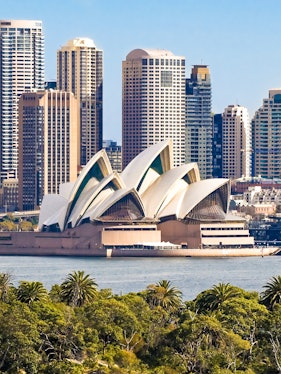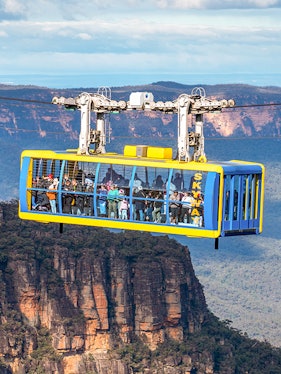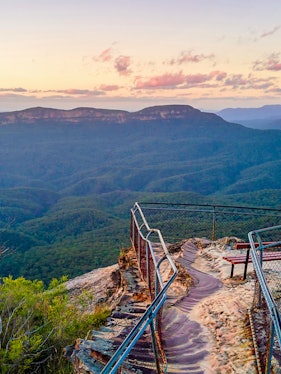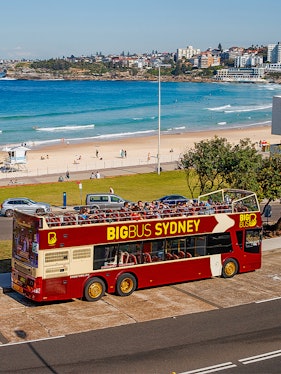- SEA LIFE Sydney Aquarium Tickets
- Sydney Opera House Tours
- Scenic World Tickets
- Sydney to Blue Mountain Tours
- Sydney Whale Watching Cruises
- Sydney Tower Eye Tickets
- Taronga Zoo Tickets
- Sydney Zoo Tickets
- WILD LIFE Sydney Zoo Tickets
- Featherdale Wildlife Park Tickets
- Madame Tussauds Tickets
- Big Bus Sydney Hop-on Hop-off Tours
- Skydive Sydney Tickets
- Australian National Maritime Museum Tickets
- Australian Reptile Park Tickets
- Hunter Valley Wine Tours
Book Whale Watching Jervis Bay Tours
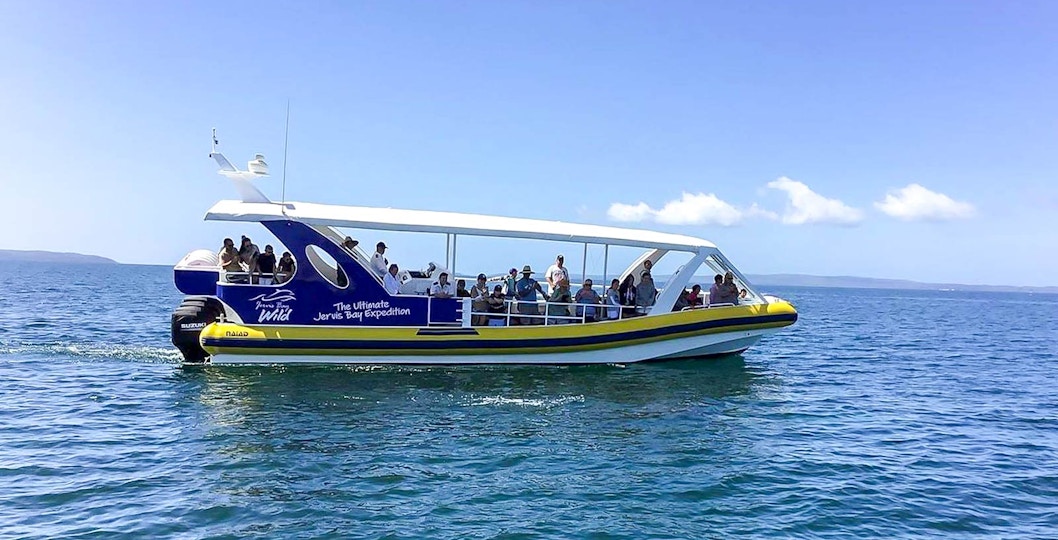
See wild whales up close through underwater viewing windows on this seasonal Jervis Bay cruise.
- Starting point: Jervis Bay Wild’s Cruise Terminal, Huskisson
- Everything you get: 2-hour whale-watching cruise aboard a purpose-built vessel with underwater viewing windows, submersible camera live feed, open-air decks, and live commentary.
- Why choose this: Get up-close with migrating whales through above-and-below-the-surface viewing, guided by marine experts.
- Route & wildlife: Cruise past Hyams Beach, sea cliffs, and Booderee coastline while spotting whales, dolphins, seabirds, and occasional seals or turtles.
See wild whales up close through underwater viewing windows on this seasonal Jervis Bay cruise.
- Starting point: Jervis Bay Wild’s Cruise Terminal, Huskisson
- Everything you get: 2-hour whale-watching cruise aboard a purpose-built vessel with underwater viewing windows, submersible camera live feed, open-air decks, and live commentary.
- Why choose this: Get up-close with migrating whales through above-and-below-the-surface viewing, guided by marine experts.
- Route & wildlife: Cruise past Hyams Beach, sea cliffs, and Booderee coastline while spotting whales, dolphins, seabirds, and occasional seals or turtles.
Inclusions
- 2-hour whale-watching cruise in Jervis Bay
- Live English commentary
Exclusions
- Sydney transfers
- Tip: If weather forces a retreat, explore nearby Hyams Beach or the White Sands Walk; both are within a 10-minute drive and offer stunning coastal scenery
- This experience is not recommended for pregnant people or people with back problems or serious medical conditions.
- This experience is wheelchair and pram/stroller accessible.
- Children must be accompanied by an adult at all times.
- Your service animals are allowed on this experience.
- This is a seasonal experience, available only from May to November.
- Please note, Jervis Bay is just over a 2.5-hour drive south of Sydney CBD.
- You can cancel these tickets up to 48 hours before the experience begins and get a full refund.
Spot wild bottlenose dolphins up close in Jervis Bay’s pristine marine sanctuary.
- Starting point: Jervis Bay Wild’s Cruise Terminal, Huskisson
- Everything you get: 1.5-hour eco-cruise with panoramic viewing decks, expert wildlife commentary, and the chance to see dolphins in their natural habitat.
- Why choose this: Australia’s healthiest marine ecosystem, Jervis Bay, where over 100 resident dolphins thrive, giving you guaranteed intimate dolphin encounters.
- Route & Wildlife: Cruise past white-sand beaches and reefs at Plantation Point and Callala, watching for dolphins, sea eagles, and the occasional seal or turtle.
Spot wild bottlenose dolphins up close in Jervis Bay’s pristine marine sanctuary.
- Starting point: Jervis Bay Wild’s Cruise Terminal, Huskisson
- Everything you get: 1.5-hour eco-cruise with panoramic viewing decks, expert wildlife commentary, and the chance to see dolphins in their natural habitat.
- Why choose this: Australia’s healthiest marine ecosystem, Jervis Bay, where over 100 resident dolphins thrive, giving you guaranteed intimate dolphin encounters.
- Route & Wildlife: Cruise past white-sand beaches and reefs at Plantation Point and Callala, watching for dolphins, sea eagles, and the occasional seal or turtle.
Inclusions
- 1.5-hour dolphin watching cruise in Jervis Bay
- Live English commentary
- Tip: Hire a kayak or paddleboard for a gentle adventure on Currambene Creek—no experience needed and you might spot more dolphins or even a sea eagle.
- This experience is not recommended for pregnant people or people with back problems or serious medical conditions.
- This experience is wheelchair and pram/stroller accessible.
- Children must be accompanied by an adult at all times.
- Please note, Jervis Bay is just over a 2.5-hour drive south of Sydney CBD.
- You can cancel these tickets up to 48 hours before the experience begins and get a full refund.
Make the most of Sydney
Compare Jervis Bay whale-watching cruises: Find the one that suits you
Plan your visit to Jervis Bay whale watching tour
- Whale Watching Cruises: 10am and 1pm
- Dolphin Watching Cruises: 10:30am and 1pm
It’s a good idea to arrive at the Jervis Bay Wild Cruise Terminal at least 30 minutes before departure.
The whale watching season in Jervis Bay runs from May to November, but not all months are the same in terms of whale activity. The best time depends on what you hope to see, here’s a quick overview:
May to August – Northbound Migration (heading to Queensland)
This is when humpback whales travel north from Antarctica to warmer breeding grounds. During these months, you’ll spot adults often breaching, tail-slapping, and showing off. It’s a great time for dramatic surface activity. Mid-June to July is particularly strong, with large pods passing through the bay.
August to November – Southbound Migration (return journey with calves)
Arguably the best part of the season, this is when mothers return south with their newborn calves. They slow down in sheltered bays like Jervis to rest, nurse, and teach their young to breach and tail-flick. The water is calmer, the encounters are gentler, and whales often come closer to the boat.
- Layer up: Even on sunny days, the sea breeze can catch you off guard. Bring a light windcheater or waterproof jacket, especially during the early whale season (May–July).
- Sunscreen and sunglasses: The sun reflects intensely off the water here, so UV protection is a must, even if it's overcast.
- Camera or smartphone: You will want to capture a breach or a dolphin leap. A waterproof pouch or dry bag is handy if you're worried about sea spray.
- Flat, non-slip shoes: Decks can get wet and a bit wobbly. Wear something that grips well and keeps you steady as you move around.
- Water bottle and snacks: While the cruises are relatively short, there are no onboard cafés. Bring water, and maybe a snack bar if you would like.
- Binoculars (optional): Not essential, but they’re fun for spotting seabirds and distant whale activity, especially from the upper deck.
- Underwater viewing windows: Available on the whale-watching cruise, these let you glimpse the whales below the surface.
- Live submersible camera feed: This real-time underwater footage is streamed onboard, giving you a unique perspective of what’s happening beneath the waves.
- Live commentary: Both tours offer expert-led commentary in English, with fun facts and ongoing wildlife insights as the tour progresses.
- Shaded and open seating: You’ll have the option to sit in the sun or under cover, depending on your preference and the weather.
- Wheelchair and stroller accessible: Both dolphin and whale-watching cruises can accommodate wheelchairs and prams, making them great for all ages and mobility levels.
- Not suitable for certain conditions: Due to the nature of the cruises, these tours aren’t recommended for pregnant passengers, or those with serious back or medical conditions.
- Hold the rails while moving: The vessel may sway unexpectedly, especially if the wind picks up or you're rounding the headland. Use handrails when walking around.
- Follow crew instructions at all times: They’re trained for both wildlife protection and your safety. If a whale or dolphin comes close, listen for directions, especially when on the bow.
- Secure loose items: Hats, scarves, sunglasses or basically anything not strapped down can fly off. Keep valuables in zipped pockets or small bags.
- Don’t reach out or lean over: Tempting as it is when a whale gets close, resist the urge to lean too far. Needless to say, you may fall!
- If seasickness is a concern: Jervis Bay is sheltered, but if you’re sensitive to motion, consider taking a preventive medication beforehand and choosing a morning cruise when waters are calmer.
Frequently asked questions about Jervis Bay Whale Watching Cruise
The whale-watching cruise lasts about 2 hours, while the dolphin-watching cruise runs for 1.5 hours. Both tours depart from Huskisson and return to the same point, so you can easily plan meals or beach time around them.
Yes, they’re family-friendly and wheelchair/pram accessible. Just note that children must be accompanied at all times, and the tours are not recommended for pregnant passengers or people with serious medical conditions due to movement on board.
If you're after flexibility, go with the whale-watching cruise, it offers free cancellation up to 48 hours before departure. The dolphin cruise is stricter, requiring 10 days’ notice for a full refund.
Yes, free street parking is available around Huskisson, especially near the Jervis Bay Wild Cruise Terminal. It’s a small and walkable town, but arriving early (at least 30 minutes ahead) is recommended during weekends or school holidays.
While sightings can’t be 100% guaranteed but know that both cruises operate in one of Australia’s most reliable marine wildlife zones. Jervis Bay has resident dolphin pods, and whales pass through regularly during the season. Operators know the hot spots and they’ll do their best to get you there.
Morning cruises tend to offer calmer seas and better lighting for photos, especially in whale season. Afternoon tours are just as scenic and can be slightly warmer. It really comes down to your travel rhythm.
No, there’s no café or kiosk on the boat. It’s best to bring your own water bottle and a light snack, especially if you're cruising during meal times. There are plenty of cafés in Huskisson for a pre- or post-cruise bite.
Plenty. You can go beach-hopping, kayaking in Currambene Creek, exploring Booderee National Park, or grab lunch by the bay.












